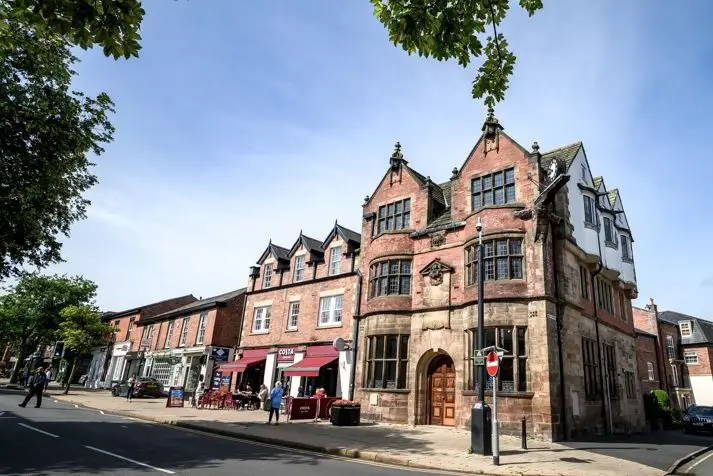A historic bank in Alderley Edge has been acquired by a local developer for £1.4 million. The developer plans to convert the former Barclays bank into their new headquarters. The transaction and forthcoming renovations signify a blend of old and new.
The three-storey building on London Road, which closed in 2022, will undergo extensive renovations. The developer aims to transform the 120-year-old structure into high-tech, energy-efficient offices, preserving its historical charm.
The Acquisition
Wilmslow-based property developer has acquired the former Barclays bank in Alderley Edge for £1.4 million. The three-storey Grade II-listed building on London Road closed its doors in 2022. Since then, it faced the risk of falling into disrepair.
Funding for this significant purchase came from Cheadle-based property lender, Together. This transaction highlights the firm’s commitment to preserving historical buildings while repurposing them for modern needs.
Planned Renovations
The developer aims to apply for planning permission to refurbish the 120-year-old structure. The goal is to convert the site into high-tech, energy-efficient offices.
Founder and CEO, Ashley Ladson, shared that the renovation is expected to be completed by July 2025, pending planning approval. He said, “It is a beautiful building – probably the most recognisable building in Alderley Edge centre.”
The new plans include extending the top floor into attic space, effectively making it two-storey with a mezzanine floor. This additional space will connect to an outdoor roof garden, providing a modern touch.
Design and Features
The interior will undergo sympathetic alterations while preserving its unique features. Elements like old paneling, cornicing, and stained glass windows will be retained. “Inside there is old paneling and cornicing, four-metre high ceilings and stained glass windows which are great original features that we will want to preserve,” Ladson explained.
The ground and first floors will boast a neo-classical design. This includes wood-panelled and glass partition walls, a feature marble bar for tea and coffee, and several break-out rooms. Ladson added, “When it’s completed it will have a feel of boutique hotel meets high-end offices.”
The building also contains a strong room in the basement and offices on upper floors. The village clock, another notable feature, will remain a part of the building, maintaining its historical charm.
Historical Significance
Designed by the renowned Manchester architect Sir Percy Worthington, the building originally opened as the Union Bank in 1904. Its distinct red sandstone façade and ornate carvings make it a landmark in Alderley Edge.
Barclays closed the branch in 2022 due to dwindling customer numbers, as more people began using online banking services. However, the building’s historical and architectural value remains significant.
Rescuing such heritage sites and repurposing them is vital for preserving local history. It allows these buildings to serve contemporary needs while acknowledging their past.
Community and Business Impact
The reimagining of the building into modern offices could have a positive impact on the local community. It will create a new hub for business activities, potentially attracting a variety of firms to the area.
Bringing new life to a key building in the centre of Alderley Edge also speaks volumes about the community’s commitment to preserving its architectural heritage. This project, therefore, stands as a testament to blending old and new.
Corporate Sales Director at Together, Ritchie Watson, expressed enthusiasm about the project. He stated, “We’re excited to see the finished article once fully redeveloped.”
Funding and Partnerships
Securing funding from Together was a crucial step for this development. The lender has supported several of the developer’s projects over nearly two decades, focusing on housing and student accommodation.
Watson commented on this long-standing relationship, saying, “We’ve worked with Ashley Ladson and the Abode team for nearly 20 years on dozens of acquisitions and development schemes.”
This collaboration reflects the trust and reliability built between the developer and the lender. It ensures that projects like these receive the necessary financial backing for successful execution.
Future Prospects
Once completed, the new headquarters will blend historical architecture with modern amenities. This will create a unique workspace environment, aiming to attract businesses and talent alike.
The renovation embodies a forward-thinking approach to development, balancing heritage and innovation. It shows how adaptive reuse can be a sustainable solution for old buildings.
Such projects set an example for future developments, demonstrating that preserving history can go hand in hand with meeting current business needs.
The transformation of the historical bank into modern offices is a shining example of adaptive reuse. This project not only preserves the architectural heritage of Alderley Edge but also brings fresh prospects for local businesses. As 2025 approaches, the completion of these renovations will likely be a source of pride for the community and a model for blending historical charm with contemporary needs.


